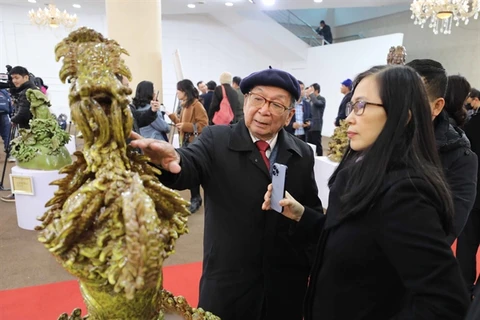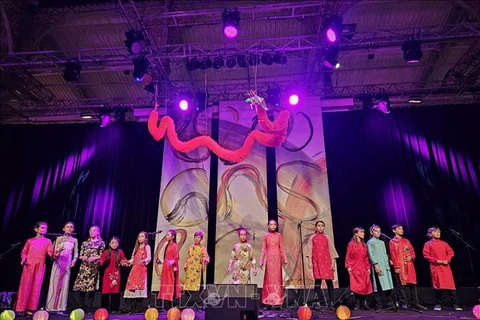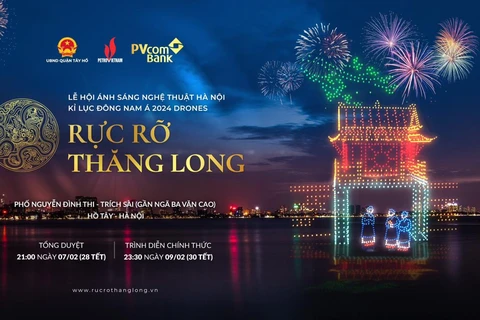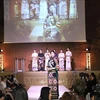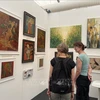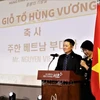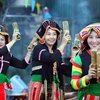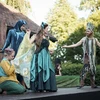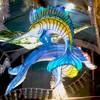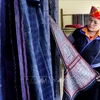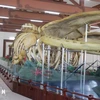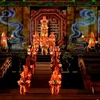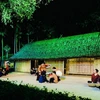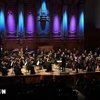Hanoi (VNA) - In Vietnam, dragons hold great significance as a sacred symbol in the nation’s history, as depicted in the legendary tale of “The Dragon and the Fairy.” Though mythical creatures, dragons have strong spiritual connection with the Vietnamese people.
Extensive studies have revealed that Vietnamese dragons possess distinct visual characteristics compared to those found in other Asian countries. Throughout different historical periods, Vietnamese dragons have undergone transformations.

Dragons decorated on a door made of carved wood, Tran Dynasty (13th – 14th centuries), Pho Minh pagoda, Tuc Mac, northern Nam Dinh province.
 A stone pillar carved in the shape of a dragon, Ly Dynasty (11th -13th centuries) is excavated from Thang Long Imperial Citadel, Hanoi.
A stone pillar carved in the shape of a dragon, Ly Dynasty (11th -13th centuries) is excavated from Thang Long Imperial Citadel, Hanoi.  Dragons decorated on architecture made from terracotta, Le Trung Hung Dynasty (17th – 18th centuries), Dai Yen village, Hanoi.
Dragons decorated on architecture made from terracotta, Le Trung Hung Dynasty (17th – 18th centuries), Dai Yen village, Hanoi. 
Bohdi-leaf-shaped architecture decorated with dragons made from terracotta, Ly-Tran Dynasties (11th -14th centuries).
Nguyen Quoc Huu, Deputy Head of the Exhibition Department at the National Museum of History, said the dragon motif has existed since the formation of the Van Lang-Au Lac state.
In 1010, King Ly Thai To relocated the capital from Hoa Lu to Dai La, and adopted the image of a flying dragon to name the new capital, Thang Long, opening up a new era of national independence and autonomy. As a result, the dragon became emblematic of kingship.
During the Tran dynasty (13th – 14th centuries), the martial spirit forged through numerous resistance wars against foreign invaders fostered a distinct ambiance and style for the Tran dynasty’s dragons.
By the early Le Dynasty (15th century), the dragon had evolved into a symbol of the monarchy. Notably, the five-clawed dragon represented a symbolic image exclusively reserved for the king.

Artist Nguyen Tan Phat with a collection of lacquer boxes inspired by dragons through Vietnamese dynasties.

Artist Nguyen Tan Phat introduces to international visitors his collection of “1,000 dragons and fairies,” displayed at a workshop in Duong Lam ancient village, Hanoi.
Artist Minh Pho believes that the 12 zodiac animals, particularly dragons, remain captivating subjects for artists. He shared that he loves the image of dragons through historical periods, and is interested in combining the traditional and modern heritage values in his works.
According to artist Nguyen Minh, incorporating dragon patterns and motifs from historical periods into contemporary paintings demands meticulous research, innovative ideas, creative forms of expression, and respect for the aesthetic and cultural values associated with dragons throughout different eras. Though this expression is challenging, it is incredibly captivating, Minh said.
Sharing the same view, artist Nguyen Tan Phat described the dragon as a tough topic for art lovers.
To welcome the New Year of the Dragon 2024, Phat has showcased a collection of 1,000 works centered around the theme of “Dragons and Fairies,” employing diverse materials such as wood, lacquer, ceramics, and metal to highlight the theme.
Among these creations, the most remarkable piece is a lacquer box adorned with depictions of dragons from various feudal dynasties and a dragon chair embellished with 2,500 gold leaves, equivalent to 500 grams of 24K gold.
“It took me two years to conceive ideas and gather research materials before deciding to integrate the dragon imagery of the Ly Dynasty. I combine it with the robust and powerful five-clawed legs and the dragon tail resembling Bodhi leaves, which originated from the flourishing Buddhist culture of the Ly Dynasty,” Phat said.
Dr. Tran Hau Yen The said incorporating the dragon motif into modern art requires not only meticulous historical research, but also broad knowledge encompassing visual arts, graphic design, heritage studies, science, and technology./.






